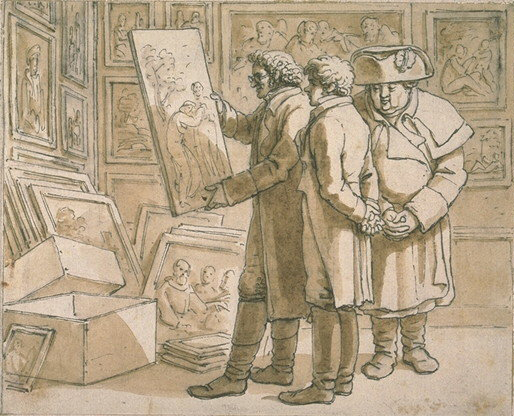Horse Head from the Quadriga of the Brandenburger Tor
This horse’s head is all that remains of the quadriga, the sculpture on top of the Brandenburger Tor in Berlin. The quadriga was destroyed by bombings during World War II. A replica was placed on the gate in 1958.
In the VR experience, you find yourself on top of the Brandenburger Tor, just when Napoleon’s troops enter the city.
King Frederick William II of Prussia commissioned this city gate in 1788, to commemorate his victory over a patriot uprising in the Netherlands. In 1795, the Netherlands eventually became French territory. The German kingdom of Prussia met the same fate in 1806.
The horse-drawn chariot had only been on the city gate for 13 years when Denon, Napoleon’s art inspector and director of the Louvre, took it to France as a trophy in 1806. Unlike many other artworks looted by the French, the quadriga had no aesthetic or historic meaning to the looters: this theft was purely symbolic. Following Napoleon’s surrender in 1814, the horses and carriage returned to Berlin, where their return was celebrated.
Each milestone in German history shifted the symbolic value of the quadriga. Originally the female figure on the chariot represented the goddess of Peace; after the French retreat the Germans changed her into the goddess of Victory. When World War II was over, the quadriga successively represented the downfall of Hitler, a divided Germany, and later a reunited and peace-loving nation.

Dutch connection
What does this German horse’s head have to do with Stadholder William V, Prince of Orange? When Dutch patriots started to demand more democracy and wanted the Oranges to be removed from power, William retreated to his estate near Nijmegen as patriot troops gained ground and came closer to overthrowing his reign. His wife, Wilhelmina of Prussia – sister of the King of Prussia – travelled to The Hague to avert this fate. When she was stopped on her way there, her brother sent an army of 26,000 soldiers to restore order. To commemorate their swift victory, he then had the imposing Brandenburg Gate in Berlin built, inspired by Roman triumphal arches.

Design
With the horse-drawn quadriga atop the Brandenburg Gate, the artist Johan Gottfried Schadow harked back to the ancient chariots used in classical antiquity for warfare, triumphal processions and horse races. It also fitted with the ‘war and peace’ theme of the monument. Creating the large sculpture group was no small technical feat. The towering figures were made out of 2 mm copper sheets, held together by internal metal structures to ensure that they could weather any storm.
In Paris
In 1806, after defeating Prussia, Napoleon entered Berlin. He was accompanied by the director of the Louvre, Dominique-Vivant Denon, who had been personally tasked with selecting artworks for the French emperor. As a symbol of the French victory over Prussia, the quadriga was to be given a prominent place in Paris. Napoleon wanted the sculpture to be mounted on a triumphal arch or on the Church of Sainte-Marie-Madeleine, but Denon believed it was too small. Instead, he wanted the horses to be placed on a fountain or at the Pont Neuf. In the end, none of these plans materialised.

Destroyed and renovated
During the Second World War, the Brandenburg Gate was badly damaged by air raids. In 1950, the remains of the quadriga were taken down. After Berlin was divided, the city gate was first located in the zone controlled by the Soviet Union, and later on the eastern side of the Berlin Wall, in the section of the city that was controlled by the German Democratic Republic (GDR). Due to strict security measures, no one was allowed to go near the monument for over 30 years. All the more remarkable, then, was the collaboration between East and West Berlin to renovate the Brandenburg Gate, in 1958. As part of these renovations, the quadriga was accurately recreated using a plaster cast from 1942.
